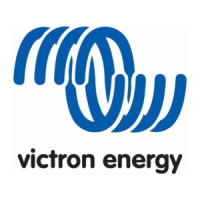
Do you have a question about the Victron energy EasySolar-II GX 48/5000/70-50 and is the answer not in the manual?
| Inverter Power | 5000 VA |
|---|---|
| Battery Voltage | 48 V |
| Charge Current | 70 A |
| Input Voltage | 230 VAC |
| DC Input Voltage | 48 V |
| Battery Charger Current | 70 A |
| Input voltage range | 187-265 VAC |
| Maximum AC input current | 32 A |
| Inverter Output Voltage | 230 VAC |
| GX Device | Integrated |
| Output voltage | 230 VAC |
| Maximum PV power | 4000 W |
| Maximum PV open circuit voltage | 250 V |
Detailed illustration of all product connection terminals and their functions.
Schematic representation of the product's internal functional blocks.
Wiring diagram and guidelines for connecting multiple units in parallel.
Wiring diagram and guidelines for three-phase system configurations.
Graphs illustrating battery charge current and voltage stages over time.
Explanation of the initial bulk charging phase within the 4-stage process.
Chart showing how charge voltage is adjusted based on battery temperature.
Drawings and specifications detailing the product's physical dimensions.
An overview of the product and the manual's scope.
Procedures for safely transporting and storing the device.
Features common to all usage scenarios of the product.
Description of the device's integrated graphical user interface.
Information on connecting compatible Battery Management Systems via CAN-bus.
Details on network connectivity for remote monitoring and management.
How the product ensures continuous power during grid failures.
Explanation of the primary and auxiliary AC output functionalities.
Information on configuring the product for three-phase systems.
Feature for optimizing power draw from limited AC sources.
Function to supplement AC source capacity with battery power.
Overview of the product's programmable features.
Details regarding the functionality and applications of the programmable relay.
Information on using an optional external current transformer for sensing.
Description of the analog/digital input/output ports and their uses.
Features tailored for hybrid solar energy systems and grid interaction.
Use of an external current transformer in grid-parallel topologies.
How the product adjusts frequency to manage solar inverter output during grid outages.
Functionality of the integrated battery monitoring system for generator control.
How the system provides power independently during grid failures.
Detailed information on the product's battery charging capabilities and algorithms.
Further guidance on charging various types of Li-ion batteries.
References to additional resources for battery and charging information.
Configuration requirements for Energy Storage Systems interacting with the grid.
Explanation of the product's main operational switch positions and their functions.
How the GX card's power state relates to the main unit's operation.
Functionality of the button associated with the GX LCD display screen.
List of system parameters and data shown on the GX LCD display.
How error codes are presented and interpreted on the GX LCD display.
Recommendations for selecting an optimal and safe installation site.
Instructions and requirements for connecting the battery cables.
Step-by-step process for securely connecting the battery cables.
Procedures for safely connecting the AC input and output cables.
Details and instructions for various optional connections.
Methods available for remotely controlling the product's operation.
Information on programming and utilizing the auxiliary relay.
Uses and configuration of the analog/digital input/output ports.
Connecting voltage sense terminals to ensure accurate battery charging.
Connecting the temperature sensor for charge compensation.
Requirements and steps for connecting multiple units in parallel for increased capacity.
Guidelines and configurations for operating the product in three-phase systems.
Instructions for connecting the product to the Victron Remote Management portal.
Default factory settings recommended for initial setup and standalone operation.
Detailed explanations of various configuration settings and their functions.
Setting for the output frequency when operating on battery power.
Acceptable range of AC input frequencies for synchronization.
Acceptable range of AC input voltages for operation.
Setting for the output voltage when the unit is in battery operation mode.
Configuration options for single unit, parallel, or three-phase system setups.
Power saving feature that reduces consumption in low load conditions.
Standby mode that minimizes power consumption by intermittent operation.
Functionality and purpose of the ground relay for AC output safety.
Description of the adaptive charging algorithm for optimal battery health.
Setting to optimize charging parameters based on the connected battery chemistry.
The duration of the absorption phase in the battery charging cycle.
Procedure for periodically overcharging batteries to balance cell voltages.
Feature for automatically performing equalization on suitable battery types.
Settings related to battery storage and periodic maintenance charging.
A safety feature that limits the maximum bulk charging time.
Setting the maximum allowable current drawn from the AC source for PowerControl.
Enables seamless switching to inverter operation during AC input failures.
Manages generator output during load changes to prevent instability.
Setting to improve charging performance with distorted AC input voltage.
Adjusts the PowerAssist feature's behavior for specific conditions.
Configuration options for the auxiliary relay's functions.
Functionality and application of the secondary AC output terminal.
Using the VEConfigure software for detailed product configuration.
Simplified configuration tool for systems with up to three units.
Software for configuring advanced applications and systems with multiple units.
A table detailing common problems, their causes, and solutions.
Specific error codes displayed by VE.Bus systems and their interpretation.
Detailed diagram and labeling of all product connection points.
Schematic illustration of the product's internal components and signal flow.
Wiring diagrams and instructions for setting up parallel unit configurations.
Wiring diagrams and instructions for setting up three-phase system configurations.
Graphs detailing the battery charging current and voltage profiles.
Explanation of the initial bulk charging phase within the battery charging cycle.
Graph showing how charge voltage is adjusted based on battery temperature.
Technical drawings indicating the product's physical dimensions and mounting points.